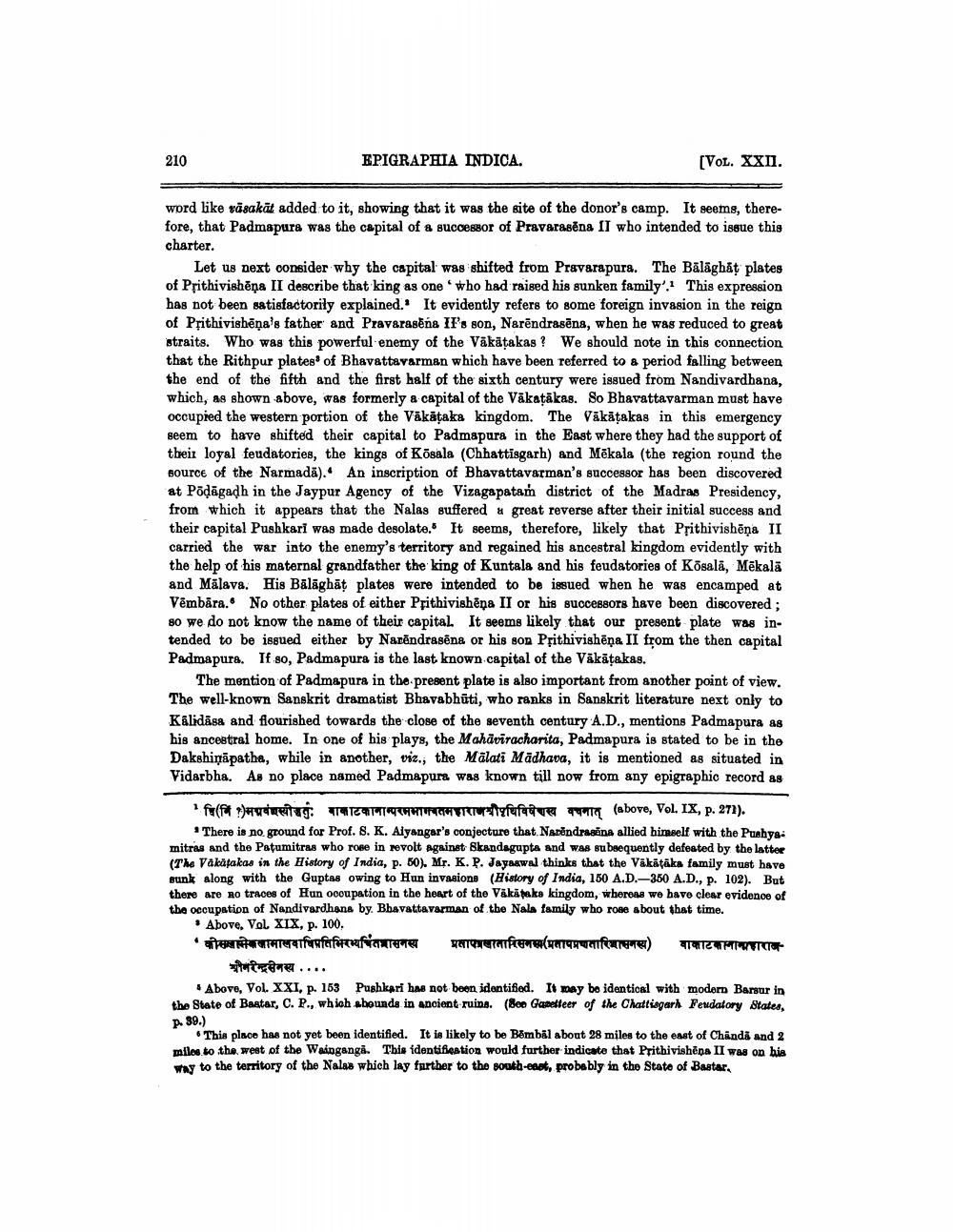________________
210
EPIGRAPHIA INDICA.
(VOL. XXII.
word like väsakāt added to it, showing that it was the site of the donor's camp. It seems, therefore, that Padmapura was the capital of a successor of Pravarasēna II who intended to issue this charter.
Let us next consider why the capital was shifted from Pravarapura. The Bāläghåț plates of Prithivishēņa II describe that king as one who had raised his sunker family. This expression has not been satisfactorily explained. It evidently refers to some foreign invasion in the reign of Přithivishēņa's father and Pravarasēna II's son, Narēndrasēns, when he was reduced to great straits. Who was this powerful enemy of the Vākāțakas? We should note in this connection that the Rithpur plates of Bhavattavarman which have been referred to a period falling between the end of the fifth and the first half of the sixth century were issued from Nandivardhana, which, as shown above, was formerly a capital of the Vākațākas. So Bhavattavarman must have occupied the western portion of the Vākātaka kingdom. The Vākāțakas in this emergency seem to have shifted their capital to Padmapura in the East where they had the support of their loyal feudatories, the kings of Kõsala (Chhattisgarh) and Mēkala (the region round the source of the Narmadā). An inscription of Bhavattavarman's successor has been discovered at Pödāgadh in the Jaypur Agency of the Vizagapatam district of the Madras Presidency, from which it appears that the Nalas suffered a great reverse after their initial success and their capital Pushkari was made desolate. It seems, therefore, likely that Prithivishēna II carried the war into the enemy's territory and regained his ancestral kingdom evidently with the help of his maternal grandfather the king of Kuntala and his feudatories of Kõsalā, Mēkalā and Mälava. His Bālāghāt plates were intended to be issued when he was encamped at Vēmbāra. No other plates of either Prithivishēna II or his successors have been discovered ; 80 we do not know the name of their capital. It seems likely that our present plate was intended to be issued either by Napāndrasēna or his son Prithivishēņa II from the then capital Padmapura. If so, Padmapura is the last known capital of the Väkātakas.
The mention of Padmapura in the present plate is also important from another point of view. The well-known Sanskrit dramatist Bhavabhūti, who ranks in Sanskrit literature next only to Kalidasa and flourished towards the close of the seventh century A.D., mentions Padmapura as his ancestral home. In one of his plays, the Mahaviracharita, Padmapura is stated to be in the Dakshiņāpatha, while in another, viz.; the Malati Madhava, it is mentioned as situated in Vidarbha. As no place named Padmapurs was known till now from any epigraphic record as
fuf* ?) weitus: TATATHATURTHER fafarave (above, Vol. IX, p. 271).
There is no ground for Prof. 8. K. Alyangar's conjecture that Napendrasēna allied himself with the Pushya: mitras and the Patumitras who rose in revolt against Skandagupta and was subsequently defeated by the latter (The Vakatakas in the History of India, p. 50). Mr. K.P. Jayagwal thinks that the Väkātāka family must have sunk along with the Guptas owing to Hun invasions (History of India, 150 A.D.-350 A.D., p. 102). But there are no traces of Hun coupation in the heart of the Vakataks kingdom, whereas we have clear evidence of the occupation of Nandivardhana by. Bhavattavarman of the Nala family who rose about that time.
* Above, VOL XIX, p. 100. • वीसलामकलामालवाधिपतिभिरभ्यर्षितमासनस्य प्रतापवानातिसमझा(प्रतापप्रच्चतारिशासनस्य) वाकाटकालाहाराक
zenu.... * Above, Vol. XXI, p. 153 Pushkari has not been identified. It may be identical with modern Barsur in the State of Baatar, C. P., which abeunds in ancient ruins. (See Gaspeteer of the Chattisgarh Feudatory States, P. 39.)
This place has not yet been identified. It is likely to be Bēmbal about 28 miles to the east of Chandi and 2 milos to the west of the Waanganga. This identification would further indicate that Prithivishēna II was on his way to the territory of the Nalas which lay further to the south-east, probably in the State of Bastar.




